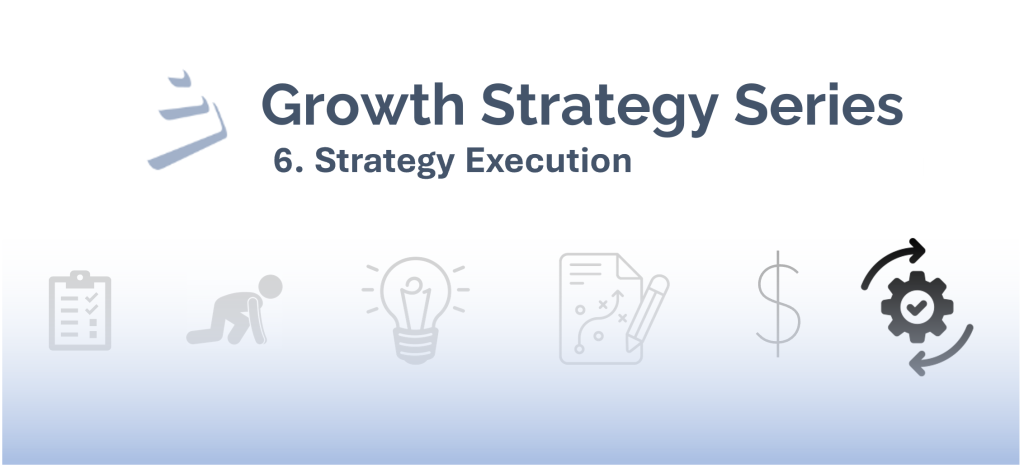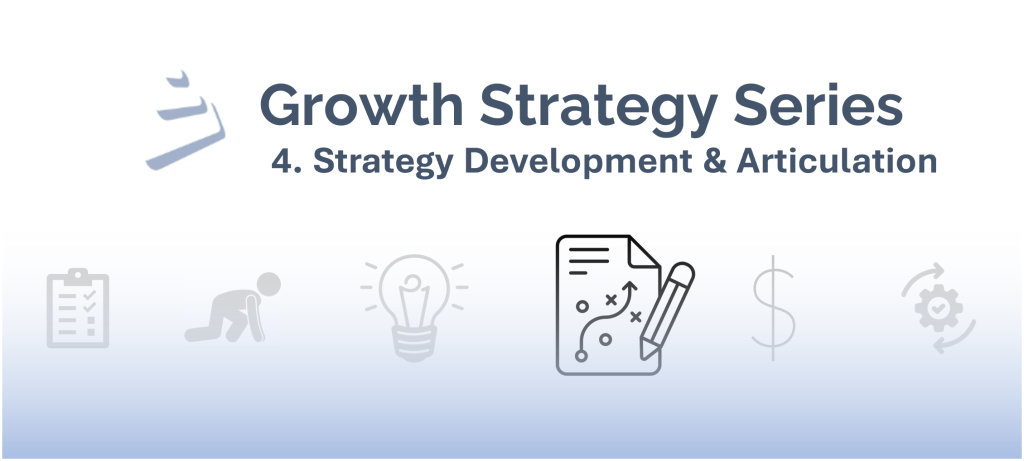Chapter 1 Recap
Welcome back to the Growth Strategy Series. In our last chapter, we discussed the importance of periodic assessments of company strategy. Key takeaways are as follows:
- All companies should dedicate part of their standard operating cycle to strategy assessment and evaluation
- Sometimes there are clear and visible signs, but subtle cultural and organizational cues can also point to the need for a revised strategy
- A valid strategy should be well articulated, choiceful, supportable, achievable, and measurable – as well as backed by deep market understanding
- A strategy assessment may lead to minor tweaks to the existing strategy, but could also lead to an entirely new strategy
- A new or improved strategy can have considerable impacts on financial, operational, and brand performance, but also leads to a better-aligned organization and healthy culture
For the remainder of this series, we will provide an overview of our process for developing and executing an entirely new company strategy. This chapter covers strategy readiness.

Chapter 2: Strategy Readiness
Strategy development requires considerable planning, expectation setting, and mobilization. Before diving into the process, there are critical steps to take to ensure your organization is prepared and set up for success. This chapter discusses…
- Managing timeline expectations: Setting expectations for how long the process will take
- Assessing the quality of current insights: Aligning on a baseline level of business and market understanding that the remainder of the process will build upon
- Identifying and allocating resources: Identifying the right people to involve along the way
- Engaging the organization: Developing a sense of excitement and urgency among team members
Manage timeline expectations
Differentiated, lasting and valuable strategies are grounded in impactful proprietary insights. Therefore, the timeline for strategy development depends on your existing understanding of both the external market and your company’s performance. Strategy development efforts can often take up to 6-8 months, with much of that time dedicated to external market research and internal analysis to uncover the insights required to make meaningful strategic choices, as well as financial modeling to quantify the resulting strategy. If your company already conducts rigorous market analysis to understand trends and growth, has a strong understanding of your position in the market relative to competitors, has a finger to the pulse of customer and consumer preferences, and has a clear picture of which areas of the business are most profitable and competitive, the timeline can be significantly shortened. See below for a typical strategy development timeline. Note that timing is subject to change depending on board expectations and review cadence, as well as annual planning process timelines.

This chapter and our following two chapters cover the entire 6-8-month end-to-end strategy development process. The remainder of this chapter focuses on the “Strategy Readiness” phase, which typically comprises the first 2-4 weeks.
Assess the quality of current insights
A critical outcome of the strategy readiness phase is a clear understanding of existing data and insights and information gaps that must be addressed:
- Does a detailed understanding of market, competitive and customer dynamics exist?
- What gaps are there, if any, and what data might be available to close those gaps?
- Is there a solid understanding of the company’s financial performance? Are the areas that drive business drive profitability understood, along with those that don’t?
- What analyses are necessary to better understand business performance, and is internal data adequate to conduct these analyses?
At the close of the readiness phase, you should have a path laid out to fill information gaps and get the most value out of the insights generation phase. The strategy readiness phase helps with resource planning for the remainder of the process, as it sets a baseline for the level of data gathering, analysis, and alignment required to develop the appropriate depth of insight for strategy development. Understanding the current state allows you to finalize a clear and realistic timeline and right-size your strategy development core and extended teams for the effort required in subsequent phases.
Identify and allocate resources
Strategy development is a career and leadership development opportunity for high potential members of your organization. It is also a time-intensive, highly collaborative, and challenging endeavor – it is critical to ensure your team is well supported and time is being properly allocated for so that they can balance their day-to-day with the demands of strategy development. When constructing your team, consider each team member through a business, functional and skillset lens. See below for a sample governance structure.

- Most commonly, the Board of Directors is the ultimate approver. Make sure to regularly keep the Board informed of progress and direction to avoid any obstacles down the road, and appoint a member of the Board as a sponsor if possible.
- Include the entire executive team on the steering committee. A strategy requires comprehensive buy-in across leadership.
- We strongly recommend a project sponsor. Project sponsors engage and motivate the organization around developing the strategy and provide guidance to the project lead to shape the process and outcome. We typically see C-level executives take on the project sponsor role but depending on your organizational structure a VP/Head of Strategy could slot in this role as well.
- The project lead manages the day-to-day process. This includes managing the timeline and deliverables, engaging with any external partners, and ensuring all stakeholders are well-informed as the strategy is developed. Project leads are typically not members of the executive team; consider appointing a high-potential emerging leader in your organization for the role of project lead as a development opportunity.
- The core team should include business unit or product line leaders and functional leadership, particularly individuals from sales and marketing, finance, and supply chain/operations. Similar to the project lead, seek emerging leaders in your organization. In our experience, we’ve found strong core team members exhibit certain personality traits, including: leadership, analytical acumen, proactivity, collaboration and an ability to challenge the status quo. Finally, be intentional about creating a diverse and well-rounded core team – similar approaches, mindsets and personalities can lead to groupthink.
- Core team sizes may vary depending on the size and breadth of your organization, but we recommend keeping things tight knit; 5-8 core team members typically works best.
- The extended team is an internal support network that is often comprised of subject matter experts from across the organization who can provide input and guidance relating to their area of expertise. Extended team sizes vary depending on organizational size and complexity, and extended team members can flex in and out of the project as needed.
- An important watch-out to team building is to make sure you give a voice to those who could derail strategy execution down the road. Include key stakeholders and influencers from across the business and value chain to promote collective buy-in to the strategy, streamline adoption, and enable better execution.
Strategy development is a critical undertaking, and the right team is essential in driving the development and execution of an impactful yet feasible strategy. You know your business best. Build a team that reflects your culture, ensures voices are heard and brings the most out of your people.
Engage the organization
Cultivating and maintaining a sense of urgency and excitement is key to developing an effective strategy. So, as a business leader, how do you get your people motivated around strategy development?
Communicate the potential impact and significance of the project. The strategy will shape the future of your company years down the road, so be sure to clearly communicate that with your team. Hold a kickoff meeting to…
- Outline goals and objectives and stress the importance of the strategy development to the company’s trajectory.
- Ensure your team understands the reason they were chosen; because they possess the right mindsets, behaviors, and skills to guide the future of the company.
- Set expectations regarding timeline, ownership and engagement.
Define a periodic review cadence with the steering committee. As mentioned, strategy development provides personal development opportunity and valuable exposure to senior leadership for the core team; that exposure to senior leadership can also cultivate urgency for the team. Defining a regular review cadence with the steering committee to show progress ensures the core team is motivated and adhering to the timeline. Encouraging core team members to present progress and results during regular steering committee updates also promotes ownership of the strategy.
Make the process rewarding. Strategy development is challenging and time consuming for members of both the core and extended teams, so recognize them for their effort and commitment.
- Publicly recognize core and extended team members for the impact they’re making on the company’s future.
- Where possible, incentivize team members to pursue training and classes to sharpen their skills and strategic thinking capability.
- Encourage unconstrained thinking. Strategy development sessions give your team the opportunity break out of their day-to-day workflows and think about the “art of the possible.” The more creative, collaborative, and dynamic discussions and workshops are, not only will the process be more enjoyable, but also the better the outcome.
The strategy readiness phase is critical, as it lays the foundation for overall success. A motivated and diverse team with an appropriate timeline and proper support will produce excellent results.
Takeaways and what’s next
- Strategy development is a significant time commitment. Start by assessing existing data and insight – If you already have a strong foundation of internal performance data, market intelligence and analysis, and customer understanding, the timeline can be accelerated considerably.
- Appoint an engaged and motivated project sponsor from your senior leadership team and target a high-potential emerging leader as project lead.
- Core and extended team size and composition may vary from company to company, but your team should include a well-rounded diverse group of leaders and emerging leaders.
- Keep the core and extended teams engaged by communicating the importance of the strategy to the organization’s future, establishing a regular review cadence with the steering committee, and recognizing and rewarding the team for their effort and commitment.
With the Readiness Assessment complete, a team in place, and an understanding of the commitment and timeline, the organization is ready to move into Phase 1: Insights Generation.

In Chapter 3, we will cover the insights generation phase of our strategy development roadmap. For questions about this piece, upcoming installments, or how we can help at any stage of strategy development, contact Mike Gill, Senior Consultant, or Pieter Rhynhart, Associate Consultant at Denneen & Company.
Denneen & Company is a growth strategy consulting firm that has been helping companies find and follow their unique paths to growth for over 29 years. With experience across 20+ industries, 40+ consumer categories, and 40+ countries, Denneen & Company consultants leverage their former backgrounds as industry practitioners and past engagements to develop practical and achievable strategies based on rigorous analysis, breakthrough insights, and a collaborative approach. To learn more, please visit denneen.com.


